| Please access the following URL if you want to secure using SSL. All pages in the site will be secure pages. |
https://secure02.blue.shared-server.net/www.fish-food.co.jp/message english 2.2023.html |
Welcome to FISH FOOD TIMES
Feb. 2023 issue No.230

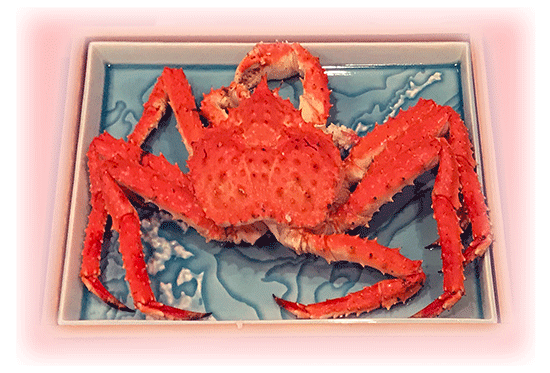
King Crab members
The war in Ukraine will soon be a year old
A year has passed since Russia unilaterally attacked and invaded its former brother country, Ukraine. In the past year in Ukraine, the mass media and other sources have reported on a daily basis that there have been many deaths, not only among soldiers but also among civilians. It seems that Russia has its own reasons for initiating the invasion of Ukraine, showing various reasons for the necessity and grounds for the use of force. However, the various military actions that Russia has taken in Ukraine over the past year that disregard the lives of civilians make me want to cover my eyes, and I cannot help but question the legitimacy of the claim itself.
Historically, Russia, despite being a large country located on the continent with a vast territory, has always been at odds with its neighbors because it is always trying to expand its territory because it is not satisfied with its size. In this war, while they were allies of the former Soviet Union, Ukraine, which has the second largest population and economic power after Russia, was getting closer and closer to NATO. It is thought that one of the causes of the war was the intention to annex Russia by force at once, as it would only become more and more distant politically from Russia if this situation continued.
Russia is a nation that always abandons treaties of friendship with other countries in order to expand its territory. This has been proved by many historical facts, and as you know, one country that has been affected is Japan. In 1941, the former Russian Soviet Union and Japan had concluded a mutual non-aggression pact with the "Japan-Soviet Neutrality Pact". On August 8, 1945, when Japan was likely to lose World War II, the Soviet Union unilaterally renounced the treaty and declared war on Japan, and began attacking Japan on August 9.
On August 9, the Soviet Union, which had preserved its military strength, invaded Manchuria with a large army of 1.6 million soldiers, and defeated the weakened Japanese Kwantung Army at once. And it is known all over the world that the Russian soldiers created hell there by repeatedly killing, looting, and raping innocent civilians who lived in Manchuria. The situation seems to be similar in Ukraine today.
On August 15, Japan accepted the Potsdam Declaration, ending the war. This should have ended the war, and Japan proceeded with disarmament, slated to finish disarmament by 4:00 p.m. on August 18. After 4:00 pm on the 18th, it was forbidden to fight the enemy, even in self-defense. However, the Soviet Union did not stop its armed aggression against Japan even after the 15th. In order to carry out the "Hokkaido occupation plan," the Soviet army began landing on Shumushu Island, the northernmost island of the Kuril Islands, which was still Japanese territory at the time. On August 18, Lieutenant General Kiichiro Higuchi, commander of the 5th Area Army at the time, received a report of the Soviet invasion and directed the remaining soldiers on the island to "counterattack and crush the landing forces.'' and gave the order.
Lieutenant-General Kiichiro Higuchi believed that if the Soviet army did not land on Japan at the water's edge, they would advance south at once and approach the main island of Hokkaido, possibly breaking out in a ground battle similar to that of Okinawa. For this reason, they decided to fight the Soviet forces until 4:00 pm on the 18th, when they disarmed.
In fact, Stalin, General Secretary of the Communist Party of the Soviet Union at the time, had a plan to occupy Hokkaido, and it seems that he intended to make at least the northeastern part of Hokkaido part of Soviet territory. However, he faced an unexpected counterattack on the occupied island of Shushum, It was on the 21st that the battle ended and the truce was halted in the direction of Hokkaido. The Japanese side suffered 600-1,000 casualties in this battle, while the Soviet army suffered 1,500-4,000 casualties. Japan had actually won, but on the 23rd, the Japanese army was completely disarmed. After that, the Soviet army landed on Etorofu Island on the 28th, Shikotan Island (the Habomai Islands) on September 1st, and Kunashiri Island on the 2nd. As you know there is. As of this September, Hokkaido was already under U.S. occupation, so the Soviet army's planned landing on the main island of Hokkaido failed, and a further Soviet invasion was stopped.
Hokkaido might have become what East and West Germany used to be and the Korean Peninsula today were it not for Lieutenant General Kiichiro Higuchi, who ordered the Soviet army to be crushed after the end of the war. In that sense, Lieutenant General Kiichiro Higuchi was a great man who made the right decision for Japan.
By the way, I think that there are many people who know this person for the first time, but in fact, he is also known as a great person who made accurate judgments in another sense. An organization called the Israeli Jewish Fund has recorded people who contributed to the Jewish people in a book called "Golden Book", and Kiichiro Higuchi's name is written here.
That was in 1938. The Jews escaped persecution in Germany, passed through Soviet territory that did not allow them to settle in peace, and reached Otpol (now Zabaikalsk) on the border with Manchuria. However, because the foreign affairs department of the Manchukuo government did not issue visas to Jews in consideration of Germany's wishes, many Jewish refugees were stuck in Manchuria. Knowing this, Kiichiro Higuchi, who was the head of the Manchukuo Harbin special affairs agency (Major General) at the time, distributed food and fuel to the Jewish refugees from a humanitarian point of view. Arrangements were made so that they could board a train of the Manchurian Railway, pass through Manchukuo, and escape to the United States, Australia, and so on. Lieutenant General Kiichiro Higuchi made a series of decisions on his own, ordered his subordinates, and rescued a total of about 20,000 Jewish refugees.
This was called the "Higuchi route" by the Jews of the time. This decision by Lieutenant General Kiichiro Higuchi was against the policy of the army and the country, as Japan had signed an Anti-Comintern Pact with Germany at the time. That is why Kiichiro Higuchi decided to risk his position as a lieutenant general. As some of our readers may know, Deputy Consul Chiune Sugihara issued visas for life to Jews in Kaunas, Lithuania, a well-known humanitarian feat, saving 6,000 Jewish refugees. It was two and a half years later.
Status of trade in marine products with Russia
Russia is such a country. Anything is possible for the interests of one's own country, and even a treaty, which is a promise between countries, is a national trait that pretends not to know anything and ignores it. There are many similar cases in relation to other countries. Such a country is currently invading Ukraine unilaterally, but if this ends in the desired outcome of Russia, it is possible that next time it will target and invade Japan, which is located at the far end of Russia. In order to prevent such a thing from happening, it is desirable for Japan that the result is the opposite of what Russia has envisioned.
One of the ways in which Ukraine's backers use sanctions against Russia is to create an economic deadlock that prevents Russia from continuing the war in terms of military funding. Naturally, Japan is also on the side of pushing Russia into a corner economically, and must cooperate in various ways. On the contrary, however, there is a movement in the fisheries industry to support Russia economically.
Below is an article published in the Minato Newspaper as recently as Friday, January 20th.
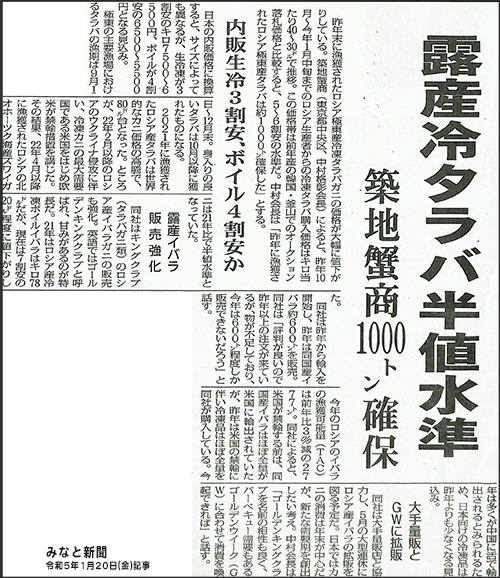
When I read this article, I couldn't help but feel a deep emotion. The simple question is whether this is allowed today.
The United States and Europe, traditionally the main destinations for Russian frozen crab exports, have imposed the embargo as part of their economic blockades. As a result, Russia's king crab and snow crab lost their main buyers, and the market price plummeted to half the level of the previous year.
It seems that China and South Korea were the first to jump on these plunging crabs, and it seems that most of the king crab and snow crab landed in Russia are exported to China and South Korea in the form of live crabs. Then, a Japanese fishery trading company joined them.As far as I know, live crabs are the mainstream of crab distribution in China and South Korea. On the other hand, frozen crabs are mainly handled in Europe, the United States and Japan, so if Russian frozen crabs cannot be exported to Europe and the United States due to the embargo, Japan will receive "good news" from Russia. is. There is a Japanese trading company that has taken over there, and the above article states that they are planning to sell these on a large scale during Golden Week in partnership with major mass retailers.
This trading company can swallow "delicious juice" to its heart's content. And these are ridiculously cheap prices when compared to the prices of crabs, which had skyrocketed until the end of last year. If fisheries wholesalers and mass retailers jump on the cheap price, the trading company should be able to earn a big profit.
To express this phenomenon in one word, it would be "Profiting while others fight".
Japan has a close relationship with Russia in terms of catching and importing marine products in the northern waters, and the fisheries industry has an inseparable relationship with Russia. For example, Japan-Russia fisheries negotiations regarding salmon and trout fishing within Russia's exclusive economic zone (EEZ) in fiscal 2022 were postponed as bilateral relations worsened due to economic sanctions against Russia, which invaded Ukraine.However, there are fishery negotiations with Russia on Russian salmon and trout that flow into Japan's waters within Japan's exclusive economic zone. The 2022 catch quota will be 2,050 tons, the same level as the year before last, and was agreed on April 22. As a result, the fisheries cooperation fee that Japan will pay to Russia will be determined in the range of 200 million to 300 million yen according to the actual catch, and the lower limit has been reduced from 260 million yen in the previous year to 200 million yen.
Looking at these facts, it seems as if the fishery industry has nothing to do with the world's economic sanctions against Russia, and fishery products are caught and traded. Therefore, the movements of Japanese trading companies dealing in crabs in the above article may not be strange at all. However, if you say that business and politics are not related, that's enough, but I would like you to think about how the economic blockade should be based on the past relationship between Russia and Japan and the current state of war between Russia and Ukraine. I wonder if that's really the right thing to do.
King Club members and globalism
The trading company that imports this Russian crab is said to handle about 600 tons of Golden king clubs in particular. It is unknown how much the major mass retailers, online sales and retailers who purchase these products will clearly indicate that they are made in Russia. Even if it is displayed, it is probably as small as possible, and it seems that it will be at a level that can not be distinguished unless you look closely.
The Japanese name Ibaragani is the English name Golden king club, Aburagani is the Blue king club, and Tarabagani is the King club. However, the crab called Ibaragani in the Japanese market is actually "Ibaraganimodoki", which was once called "Hokuyo Ibaragani", and the official Japanese name is not Ibaragani.
The price of boiled frozen Russian golden king crab was $78/kg two years ago, but it plummeted to $20/kg at the end of last year. In the background of this crash, Western countries do not buy crabs from Russia at all. The price drop is so extreme that it seems as though Russia has begged Japan to buy it, even if only a little, because it will make it cheaper anyway.
As of the end of January, on an online sales page, the retail price of Russian boiled golden king crab was 4L standard 800g size, which was sold at 4,980 yen including tax. This selling price is about 5,600 yen/kg, and if one dollar is converted to 130 yen, it will be sold at a selling price of 43 dollars/kg.
This selling price is undoubtedly attractive when compared to retail store prices during the holiday season at the end of last year. It seems that there are buyers who want to work on this trading company's sales if this retail price can be realized. There are people who think that business cannot do anything if they consider the world situation, the position of Japan, and the international situation of foreign countries such as Ukraine, and if they can get crabs at a reasonable price, some people may want to sell a lot of these and make a profit. Perhaps this kind of person is "quick to see the opportunity" and is surely good at worldly and may be more money-making than others.
Until now, Japan has collected things from all over the world with the idea that if cheap things exist somewhere in the world, not only from Japan, but from any foreign country. And in the past few years, we have been exposed to major changes in the world situation, such as the corona crisis, the Ukraine war, the depreciation of the yen, and the turmoil of the global distribution network. For this reason, we are no longer in a situation where we should buy cheap products from foreign countries as we used to. If we continue to rely on foreign products without restraint, for example, the price of Atlantic salmon from Norway, which has skyrocketed this year, there will be no way for Japan to do anything about it, and it may continue to be at the mercy of the shipping source.
Surrounded by the sea, Japan is supposed to be rich in fishery resources, but the fishery industry is in a difficult situation where there is no way to deal with raw salmon in terms of prices and procurement sources, and there are other similar examples. For example, timber that is suffering from wood shock. Japan's forestry industry has been driven into a catastrophic situation because Japan has relied on cheap foreign timber without valuing its abundant domestic forest resources.
About 69% of Japan's land area is covered by forests, which ranks second only to Finland among developed nations. It is said that the deforestation rate (amount of deforestation/amount of growth) to grow a healthy forest should be 60% to 80% of the amount of tree growth, but the deforestation rate in Japan is about 26%. Finland's deforestation rate is unusually low at 75%. In Japan, trees that grow day by day are not cut down, so the accumulation of forests continues to grow. Japan has such a strange contradiction that anyone can think of, and now the Japanese forestry industry is in a dying state.
This fact is considered to have an aspect of Japan's excessive globalism so far. Even if there are various excuses and historical backgrounds that have led to such a result, it seems that a part of the failure of Japan's agricultural, forestry and fisheries policies in reality is appearing as a distortion.
Fishery Policy for Domestic Red Snow Crab
Now, in order to understand what kind of situation Japan's fisheries policy is in, let's take the red snow crab, which is a member of the same crab family, as an example. There is currently no import of red snow crab from foreign countries, and it is almost unaffected by trends in crab catches in foreign countries such as Russia and the United States. Although there are some conflicts between fishing boats in the Sea of Japan and South and North Korea, I think it is easy to understand the content of the efforts because there is an environment in which domestic circumstances are basically used in fishery policy.
The following article is based on the material "Red snow crab Japan Sea subpopulation 2022 stock assessment results" announced by the Fisheries Agency. Red snow crab fishing grounds are divided into waters permitted by the minister and waters permitted by the governor, as shown in the diagram below. All red snow crab caught by fishing boats in waters permitted by the minister are landed at the Sakaiminato Fish Market in Tottori Prefecture.
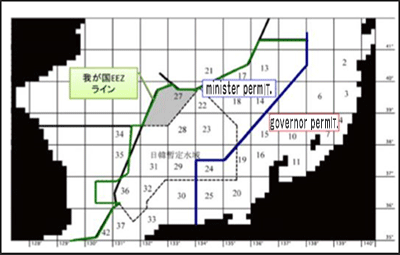
Red snow crab was introduced in 2007 with an IQ (Annual Individual Quota per Vessel), within which the 2021 red snow crab catch was 11,179 tonnes. By the way, South Korea's red snow crab catch in the Sea of Japan in 2021 was 16,637 tons.
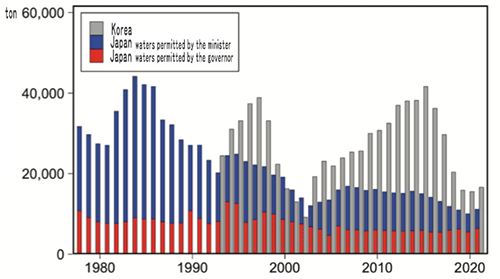
And stock assessments for red snow crab have recently been on the rise, as shown in the graph below. It seems that the effects of the introduction of red snow crab IQ (annual individual quota for each vessel) in 2007 are gradually appearing.
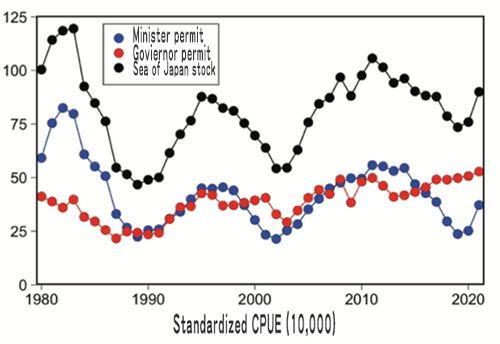
The red snow crab landed at the Sakaiminato fish market in December 2022 has a landing volume of 432 tons (88% compared to the previous year in the same month), a landing volume of 480 million yen (104%), and an average unit price per case (about 30 kg) of 33,400 yen.In January, the market price fluctuated from 20,000 yen to 30,000 yen per case, and there is strong demand as a substitute product for snow crab, which soared last year, and the market price remains high in January.
However, even though the market price continues to be high, it costs around 700 to 1,000 yen per kg, so it is cheaper than king crab or snow crab. The reason why the price of red snow crab is low is that its meat is watery and loses its freshness quickly, making it difficult to handle as a valuable perishable product.
Products made from processed red snow crab are produced by manufacturers in Sakaiminato City and Yonago City into stripped meat, flakes, sweets, and other products, and are sold nationwide. It seems that stripped meat and flakes, which are the ingredients, are also imported from South Korea as "crab prepared products" caught in the same Sea of Japan and passed to Japanese manufacturers. In other words, red snow crab itself is not actually imported, but red snow crab is imported from South Korea and other countries as crab prepared products. When it comes to the level of processed goods, the influence of foreign countries is unavoidable.
Products using red snow crab
Well, I would like to conclude this month's issue soon. Although the description has changed from king crab menbers to red snow crab, I had no choice but to explain the global environment surrounding crab products, one of the marine products, and the position of Japan. Finally, I would like to conclude by writing down the FISH FOOD TIMES-like things below.
This is a proposal for crab chirashi sushi using red snow crab flakes at the Doll's Festival on March 3 next month. Unfortunately, I don't think such a proposal is uncommon these days, so I'd like to keep it low-key in the end.
| Crab chirashi sushi |
|---|
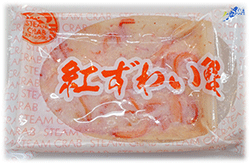 |
| 1,Prepare vacuum-frozen crab flakes using red snow crab. |
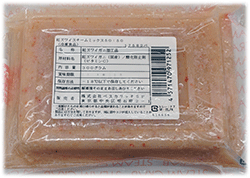 |
| 2,The sticker on the back indicates domestic production, so the production area may be Sakaiminato. |
 |
| 3,This is what it looks like when you defrost and relax. |
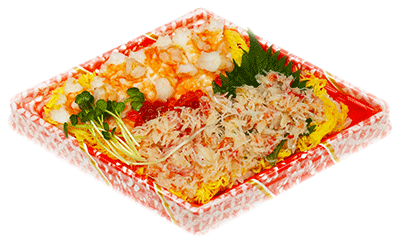 |
| 4It is completed by putting half of the boiled shrimp in a container with the image of the Hinamatsuri. |
This month's issue may have become an article not like FISH FOOD TIMES. I think that some of the readers may have felt that it was all text and not interesting at all. This is my excuse, but with the 230th issue of this issue approaching its 20th anniversary, the target fish to be picked up is limited, and I often worry about what to do with the content of the article.
For this reason, in the case of this month's issue, I reacted sensitively to the information I saw, and decided to write such an article. And recently, I sometimes wonder how long I can continue FISH FOOD TIMES. While I am aware that there will be various opinions for and against the format of articles in this month's issue, I would like to somehow continue FISH FOOD TIMES as well.
| Please access the following URL if you want to secure using SSL. All pages in the site will be secure pages. |
https://secure02.blue.shared-server.net/www.fish-food.co.jp/message english 2.2023.html |
An opinion and the communication are to iinfo@fish food times
Date of updating 1 Feb. 2023
